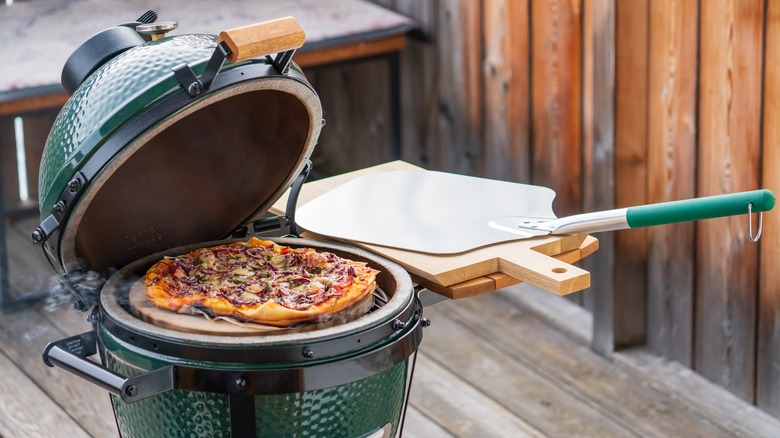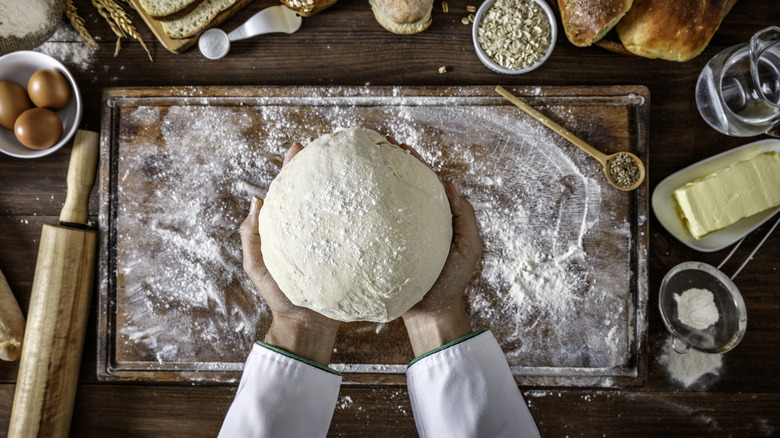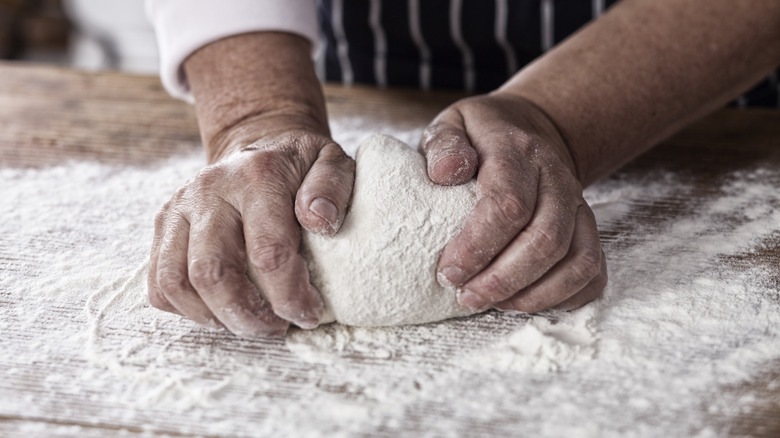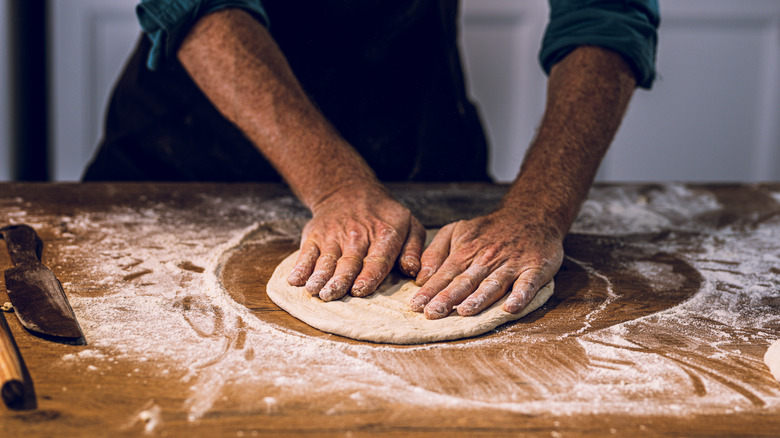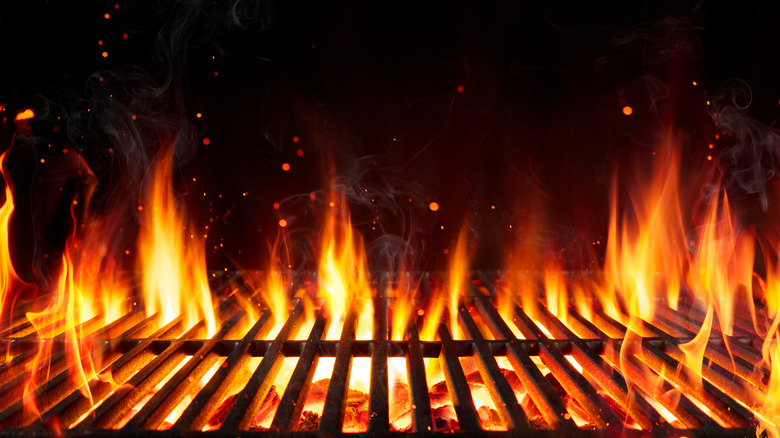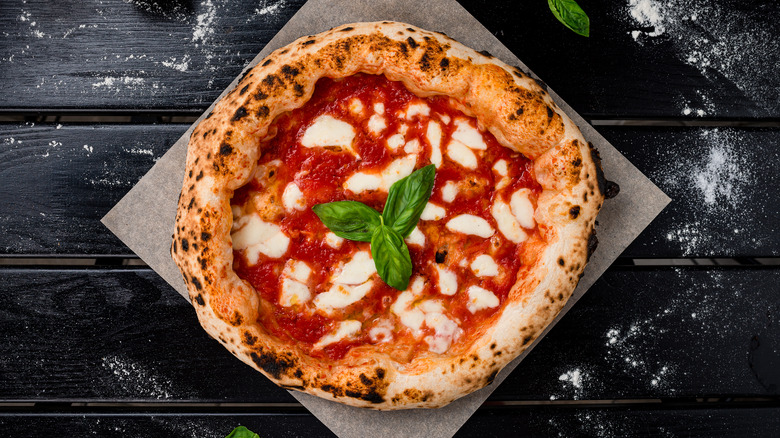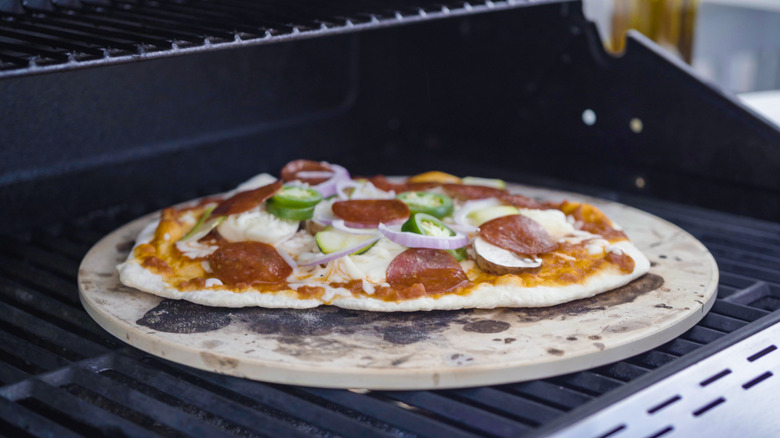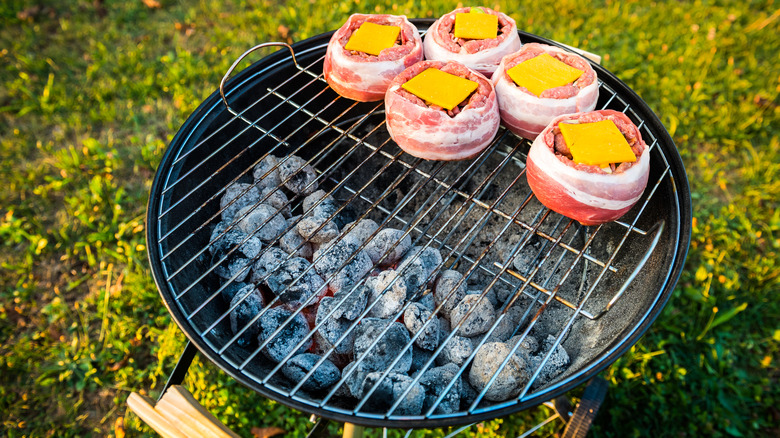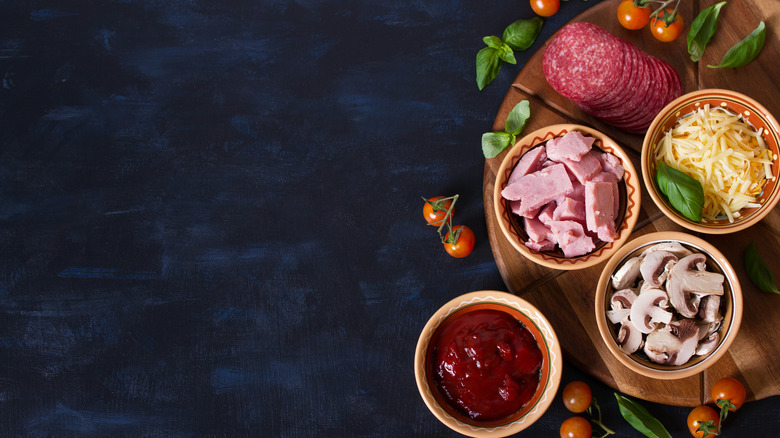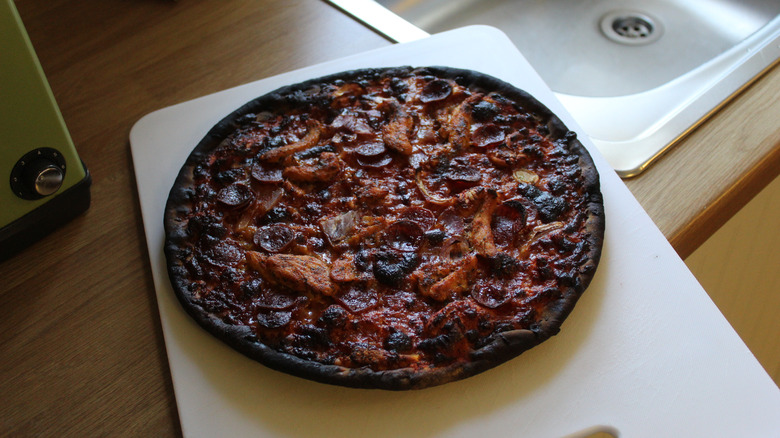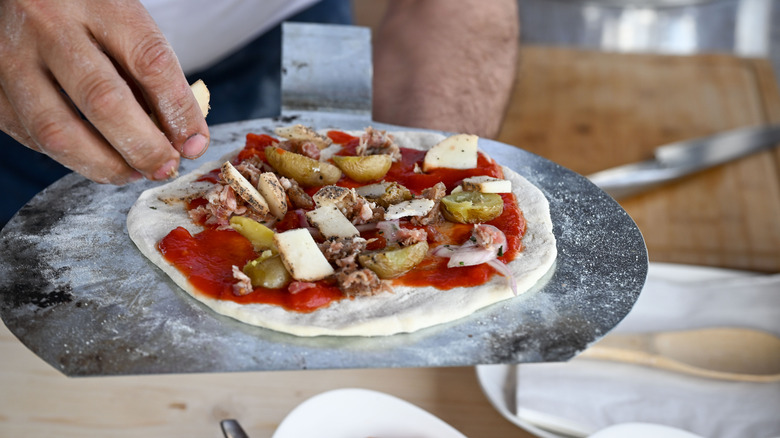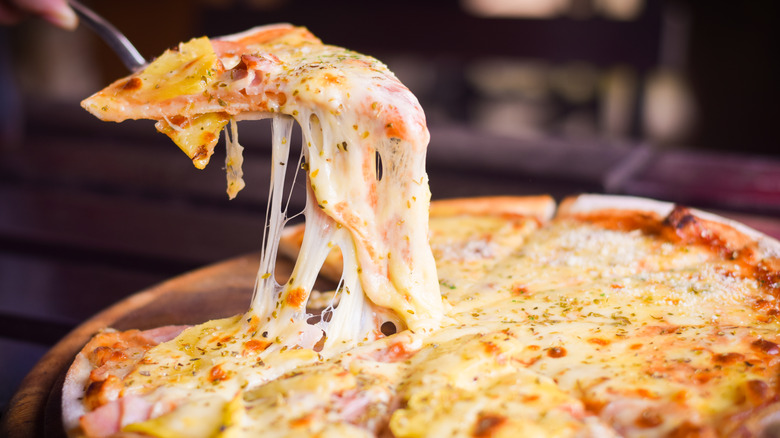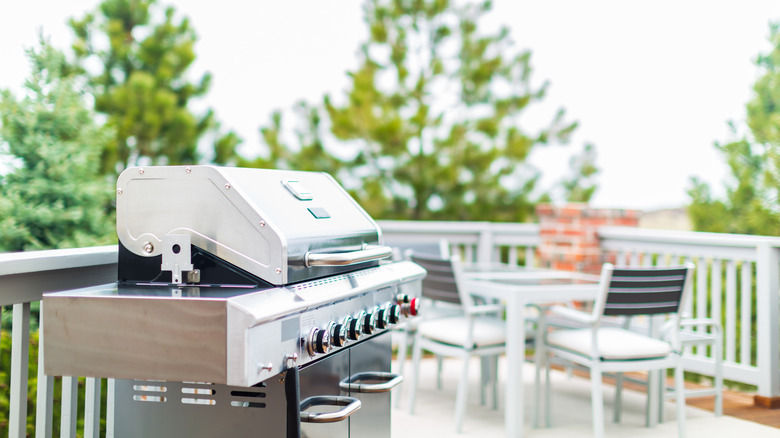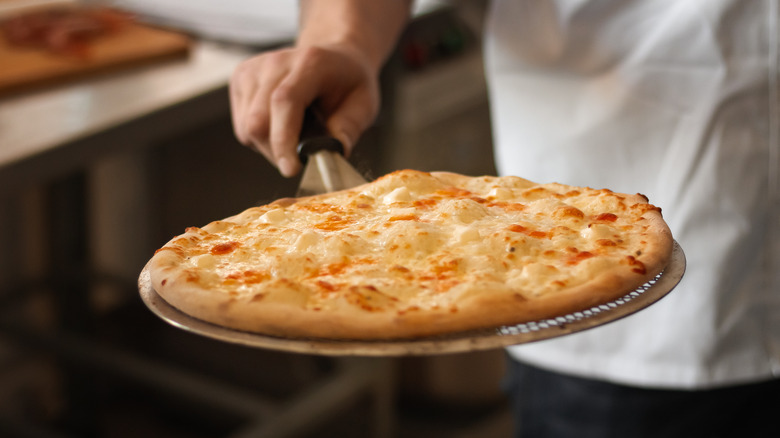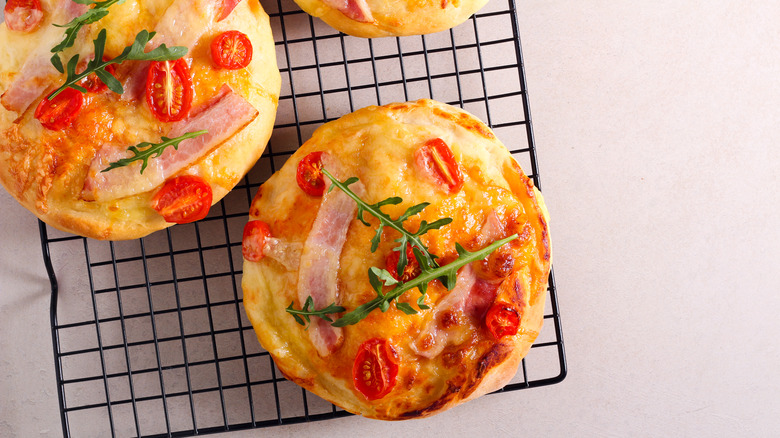15 Mistakes To Avoid When Cooking Pizza On The Grill
Summertime is made for relaxing in the beautiful weather, enjoying abundant produce at the farmers market, and — of course — spending time outside cooking on the grill. The combination of sizzling food, smoky aromas, and the social aspect of gathering around the grill creates an atmosphere that is hard to resist. Grilling pizza is an unconventional approach to cooking this well-known dish, but it offers a unique and flavorful twist to traditional versions. It cooks so much more quickly and results in a crisp and smoky crust that's simply irresistible.
Grilling pizza provides a fantastic opportunity to take your cooking outdoors for backyard gatherings or quick-and-easy weeknight dinners that don't heat up the house. Achieving the perfect grilled pizza requires a little practice, but it's easy to avoid disappointing results if you avoid a few common mistakes. You'll master the art of grilling quickly after understanding pitfalls like improper dough preparation or incorrect heat management. Before you know it, you'll be creating restaurant-quality creations from the comfort of your own backyard.
1. Not making the dough in advance
Preparing pizza dough in advance is essential for creating a successful grilled pizza. This type of dough is relatively simple — a combination of water, salt, yeast, and sometimes sugar and oil — but it needs time to ferment and rest. One of the best tips for making homemade pizza crust is to make it the day before, allowing the proteins and gluten structure time to rest overnight and develop the ideal flavor and texture. You'll find that the dough is easier to stretch and it has the perfect balance of chewiness and crispness instead of a crackery finish.
If you don't have time to make pizza dough in advance, take advantage of premade products. Your favorite pizza restaurant may allow you to buy dough to-go, or most grocery stores carry fresh dough in the refrigerated section. For best results, look for the dough in a one-pound bag instead of the kind that comes in a tube near the biscuits.
2. Using dough straight out of the refrigerator
If you find your dough difficult to work with, or if it bubbles excessively as it cooks, you're probably not taking your dough out of the refrigerator early enough. Cold dough is more difficult to work with because it's so stiff. It's resistant to stretching and springs back into a small shape very quickly after being rolled out. The result is uneven thickness or potential tearing or misshaped dough, leading to subpar results.
Allowing the dough to come to room temperature before grilling ensures a pliable, manageable dough that's easier to shape. Tempered dough yields a better final result because the dough is less likely to create large bubbles as well. This does require some planning ahead, as 2½ hours is the ideal timeframe to remove the dough from the fridge. If you happen to forget, don't worry; even pulling the dough 30 minutes before stretching it can be extremely beneficial.
3. Trying to make the dough too thin
There's a time and place for thin-crust pizza, but the grill is not one of them. The grill's intense heat is more direct than most pizza ovens, so attempting to roll out the dough too thin can lead to problems. Instead of becoming light and crispy, the delicate dough will be more susceptible to charring, imparting a bitter flavor to the pizza. Too-thin crust may also lack the structural integrity to hold the toppings properly. It can become fragile and prone to tearing or falling apart during the grilling process, especially during the stage that requires you to flip the pizza dough over. A slightly thicker crust allows for more even cooking and an easier grilling session.
Another mistake to steer clear of when forming pizza dough is the use of a rolling pin. While it's tempting to use a rolling pin, this can make the pizza dough too thin and can have other textural consequences. A rolling pin pushes out the gas bubbles that contribute to the pizza's light and airy texture, resulting in a denser, tougher crust. Instead, stretch the dough by hand, a process that takes some practice but results in better control over the thickness of the crust while preserving the best texture.
4. Forgetting to preheat the grill
Whether you're using a gas, charcoal, or electric grill, you always want to preheat the grill before making pizza. Preheating is such an important cooking step because it ensures the grill reaches the necessary temperature before optimal cooking. This process is especially important with a charcoal grill, as the coals need time to transform from active flames that might burn the pizza dough to burning embers.
Improper cooking temperatures can lead to the pizza dough sticking to the grates, making it difficult to flip, and increasing the chances that you might tear a hole in the dough. Without preheating, the pizza may take longer to cook, too, leading to a doughy crust and potentially overcooked toppings. Preheating also helps create those coveted grill marks on the crust. Since we eat with our eyes first, this element of visual appeal is crucial! The high heat of a preheated grill sears the dough, enhancing the look and the overall taste by infusing it with a touch of smoke and char.
5. Grilling pizza over low heat
If you notice that your homemade pizza crust is too hard, it may be related to the cooking temperature. Low temperatures are tempting because it seems less likely that you'd burn the pizza, but it's actually much better to use a higher temperature. The dough can dry out in a low-temperature grill or oven, turning it hard and tough as the dough becomes dehydrated. It can also stick if the temperatures are way too low. There's a delicate balance between the temperature and the dough so the dough cooks quickly and evenly without turning soggy or hardened.
The actual temperature may vary depending on your specific grill, but in general, we find that it's best to set the grill for a two-zone fire. On the direct side, temperatures between 425 to 450 degrees Fahrenheit tend to be best. This allows you to quickly cook the pizza dough, locking in the moisture so it has the ideal crispy (but not hard) texture. The indirect side should be between 375 to 400 degrees Fahrenheit to warm the toppings through and melt the cheese without burning the bottom. If the temperature is too low, the dough will continue to dry out as the cheese refuses to melt.
6. Trying to use a pizza stone
Many people use a pizza stone on their grills. Most pizza stones are rated for high heat and can be used directly on the grill grates. While there's really nothing wrong with using the stone, we find several advantages to grilling the dough directly on the grates. The grates allow direct heat transfer, so the cooking process is faster and more efficient. They also allow for better heat circulation and airflow around the pizza to ensure even cooking The direct contact also enhances the overall flavor of the pizza, adding a light smoky flavor that permeates every bite — just like a wood-fire oven. As a bonus, this process also creates distinctive grill marks and crisp edges.
The direct grilling method also provides more flexibility when it comes to the size and shape of the pizza. Many pizza stones are round and come in fixed sizes, so you'll be limited in the diameter that fits on the rectangular grill. Even if you have a square stone, grilling directly on the grates allows you to take advantage of the entire cooking area and create a larger, flatbread-style pizza.
7. Using only direct heat instead of incorporating indirect heat
Grilling pizza is a two-stage process that utilizes both direct and indirect heat. If you're trying to use only one of those methods, the pizza will turn out less than successful. For the perfect balance of crispy crust and properly cooked toppings, you need to create a zone on the grill where the heat source is not directly underneath the pizza. Start cooking the dough on the direct side and flip it to the indirect heat side. This prevents the bottom of the pizza from burning in the time it takes to melt the cheese.
Indirect heat also helps to avoid undercooked or raw toppings. When you close the lid on the grill, the hot air circulates around the pizza, gently cooking the toppings while the crust gets the desired level of crispness. The indirect heat side also allows more control over the cooking process. Without direct access to the flame, there is less risk of burning the pizza.
8. Not preparing the toppings in advance
We once knew a culinary school instructor who said the key to being prepared is preparation. It sounds simplistic, but it's true. Getting the ingredients ready in advance means you'll be less stressed, and you can sprinkle the toppings onto the pizza with ease instead of scrambling around to chop a last-minute ingredient. We recommend preparing a mise en place — a French culinary term that means "everything in place." You can use the muffin tin trick to seriously simplify your mise en place, putting different ingredients in each cup instead of using a dozen different bowls.
Part of this preparation involves understanding which ingredients can be used raw and which benefit from being cooked before adding them to the pizza. Quick-cooking ingredients like thinly sliced vegetables or fresh herbs can be added to the pizza without advance cooking. The same can be said for any pre-cooked toppings that simply need to be warmed through, like sliced pepperoni or smoked salmon. Hearty vegetables like bell peppers, mushrooms, or eggplants may benefit from pre-cooking to enhance their texture, and all raw meat toppings (like ground beef, sausage, or chicken) should be cooked thoroughly first to ensure they are safe to consume.
9. Forgetting to oil the pizza dough
There's no need to oil the pizza dough when cooking it a pizza oven or in the oven with a pizza stone. These surfaces are designed to cook dough without causing it to stick, so it's easy to get the pizza out of the oven. While a properly-prepared grill can be used without oil, grilling pizza directly on the grates can be a delicate process. Applying a thin layer of oil to the dough creates a barrier that adds in nonstick protection, preventing the dough from tearing or losing its shape when attempting to flip it.
Oiling the dough can also help to enhance the overall flavor of the crust, sealing in moisture during the grilling process to prevent it from drying out. You can also take advantage of infused oils to make the pizza taste even better. Try using the oil-infusion tip to make use of your kitchen scraps and add herbs, garlic, or chili flavor to the oil. Then, brush this oil onto the pizza dough just before adding it to the grill. When the pizza bubbles and is ready to flip, brush a light layer onto the top side before giving it a flip to the indirect heat side.
10. Topping the dough before grilling it first
Trying to cook the pizza in one stage — adding all the toppings before grilling the dough first — will lead to disaster. The dough will be undercooked but burnt, and the toppings won't be cooked evenly. The cheese might melt from the high heat, but large chunks of sausage could still be cold in the middle. Instead, it's best to grill pizza in a two-step process: Cooking a disc of oiled dough on the direct heat side before flipping it onto the indirect heat side. Once it reaches the indirect side, you can add all your prepared toppings and close the lid until the pizza is finished cooking. You'll know it's finished when the cheese is melted and the toppings are warmed through.
If it sounds too overwhelming to do both steps in one sitting, or you're preparing several pizzas for a party, we have a solution. You can pre-grill the dough in advance, grilling it lightly on both sides before transferring it to a wire rack to cool. The wire rack will keep the bottom from getting soggy. Then, a few hours later, you can preheat the grill, add the pre-cooked doughs to the indirect heat side, and reheat the crust while you're melting the toppings.
11. Going too heavy on the sauce and toppings
One of the most important tips to ensure perfectly crisp pizza crust is to not overdo it on the toppings. The excess moisture and weight of numerous toppings can lead to a soggy and undercooked crust. So, exercising restraint and keeping the number of toppings to a minimum ensures the dough cooks properly and maintains the desired texture.
Piling on too many toppings can also make the pizza difficult to handle. A heavily-topped pizza can be structurally unstable, so it can be challenging to maneuver it without toppings falling off. In the worst-case scenario, this mishandling can cause the dough to tear apart. Less is more when it comes to grilled pizza, so we recommend using high-quality ingredients and selecting just a few toppings in addition to sauce and cheese.
12. Using the wrong cheese
When it comes to choosing cheese for pizza, some options work better than others. Mozzarella is a classic choice because of its excellent melting properties, and it also has the right texture for pizza. It creates a gooey, stretchy texture that's simultaneously creamy and chewy. It also has a delicate flavor that complements a wide variety of toppings. Other cheeses that work well are provolone, fontina, or a blend of Italian cheeses.
Some cheeses melt well but are not the best choice for pizza. Cheddar cheese, for example, is an oily cheese, so it may create an ideal melting pattern but it needs to be paired with the right sauce and toppings to work. Other hard cheeses don't melt well — like Parmesan or Pecorino Romano — and are best used in a blend situation instead of by themselves. Some soft, high-moisture cheeses (like ricotta or feta) are great for adding flavor to pizza, but they don't become stringy when they melt, and these cheeses can contribute to a soggy crust when they release water. It's not that they can't be used, but a proper mixture of cheeses and toppings should be considered before proceeding so they don't negatively impact the pizza's overall texture.
13. Not closing the lid after adding the toppings
Closing the lid when grilling pizza helps to create an optimal cooking environment. The lid traps heat inside the unit, creating a convection effect within the grill that circulates heat around the pizza. This helps the crust cook from the bottom and the top simultaneously, promoting even cooking and helping the cheese to melt.
If you don't have a lid for your grill, you can utilize a few hacks to achieve similar results. One option is to create a makeshift lid using a heat-safe bowl or invert a baking sheet over the pizza. Another approach would be to use an aluminum foil tent to mimic the heat-trapping properties of a lid. Be sure to monitor the cooking process, as these methods don't trap 100% of the heat inside the grill like a true lid. They will work in a pinch, but the improvisation can impact the overall cooking time.
14. Not being prepared to move the finished grilled pizza
Now that you've created a perfect pizza, you need to be prepared to move it from the grill. Trying to take it off with a small spatula or a pair of tongs can lead to the pizza folding in half, ruining all your hard work. A pizza peel is really best because it slides under the entire surface of the cooked pizza, but it is possible to remove the pizza without one. For this, you'll need a combination of tools, starting with a long-handled grill spatula with a wide, nonflexible head. Place this spatula underneath the pizza, reaching all the way to the far end. Then, position a pair of heat-resistant grill tongs to grasp the opposite end of the pizza. Be careful not to squeeze the pizza or exert too much pressure on the crust.
When you're ready, carefully lift the pizza with the spatula. The tongs will provide support and stability on the other end, helping you move the pizza with dexterity and grace. It may take some practice, so utilize help from someone else if possible. They can hold the pizza peel or cutting board close to the grill so you don't have to move it too far.
15. Letting grilled pizza sit on the plate too long
You have worked very hard up until this point to create the perfect crispy crust for your grilled pizza, so it would be a shame to allow it to get soggy on the plate. When the pizza is removed from the grill, the crust releases a small amount of steam. Placing it on a plate or cutting board will force the bottom to reabsorb that steam, turning the crust soggy.
Instead, it's best to move the pizza to a wire rack. This is especially true if you're preparing more than one pizza and letting the finished products sit for a few minutes before eating it. The wire rack will promote airflow and keep that steam from adding moisture to your perfect crisp dough. When you're ready to eat, transfer the pizza to a cutting board or pizza peel and slice it into the desired number of pieces.
